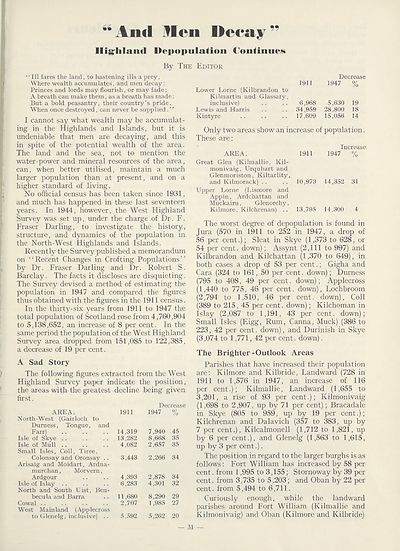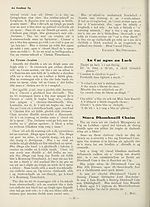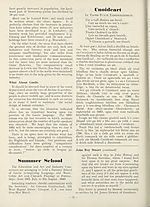An Comunn Gàidhealach Publications > Gaidheal > Volumes 44--45, January 1949--December 1950
(63) Page 31
Download files
Complete book:
Individual page:
Thumbnail gallery: Grid view | List view

“And Hen Decay”
IligiilaiMl Depopulation Continues
By The Editor
‘ ‘ 111 fares the land, to hastening ills a prey.
Where wealth accumulates, and men decay:
Princes and lords may flourish, or may fade;
A breath can make them, as a breath has made:
But a bold peasantry, their country’s pride.
When once destroyed, can never be supplied.”
I cannot say what wealth may be accumulat¬
ing in the Highlands and Islands, but it is
undeniable that men are decaying, and this
in spite of the potential wealth of the area.
The land and the sea, not to mention the
water-power and mineral resources of the area,
can, when better utilised, maintain a much
larger population than at present, and on a
higher standard of living.
No official census has been taken since 1931,
and much has happened in these last seventeen
years. In 1944, however, the West Highland
Survey was set up, under the charge of Dr. F.
Fraser Darling, to investigate the history,
structure, and dynamics of the population in
the North-West Highlands and Islands.
Recently the Survey published a memorandum
on ‘ ‘ Recent Changes in Crofting Populations
by Dr. Fraser Darling and Dr. Robert S.
Barclay. The facts it discloses are disquieting.
The Survey devised a method of estimating the
population in 1947 and compared the figures
thus obtained with the figures in the 1911 census.
In the thirty-six years from 1911 to 1947 the
total population of Scotland rose from 4,760,904
to 5,138,652, an increase of 8 per cent. In the
same period the population of the West Highland
Survey area dropped from 151,085 to 122,385,
a decrease of 19 per cent.
A Sad Story
The following figures extracted from the West
Highland Survey paper indicate the position,
the areas with the greatest decline being given
first.
Decrease
AREA.
North-West (Gairloch to
Durness, Tongue, and
Farr)
Isle of Skye ..
Isle of Mull
Small Isles, Coll, Tiree,
Colonsay and Oronsay ..
Arisaig and Moidart, Ardna-
murchan, Morvern,
Ardgour
Isle of Islay ..
North and South Uist, Ben-
becula and Barra
West Mainland (Applecross
to Glenelg, inclusive) ..
1911 1947 %
14,319 7,940 45
13,282 8,668 35
4,082 2,657 35
3,443 2,266 34
4,393 2,878 34
6,283 4,301 32
11,680 8,290 29
2,707 1,985 27
5,592 5,262 20
Decrease
1911 1947 %
Lower Lome (Kilbrandon to
Kilmartin and Glassary,
inclusive) .. .. 6,968 5,630 19
Lewis and Harris .. .. 34,959 28,800 18
Kintyre 17,609 15,056 14
Only two areas show an increase of population.
These are:
Increase
AREA. 1911 1947 %
Great Glen (Kilmallie, Kil-
monivaig, Urquhart and
Glenmoriston, Kiltarlity,
and Kilmorack) .. .. 10,973 14,352 31
Upper Lome (Lismore and
Appin, Ardchattan and
Muckairn, Glenorchy,
Kilmore, Kilchrenan) .. 13,795 14,300 4
The worst degree of depopulation is found in
Jura (570 in 1911 to 252 in 1947, a drop of
56 per cent.); Sleat in Skye (1,373 to 628, or
54 per cent, down); Assynt (2,111 to 997) and
Kilbrandon and Kilchattan (1,370 to 649), in
both cases a drop of 53 per cent.; Gigha and
Cara (324 to 161, 50 per cent, down); Durness
(795 to 408, 49 per cent, down); Applecross
(1,440 to 775, 46 per cent, down), Lochbroom
(2,794 to 1,510, 46 per cent, down), Coll
(389 to 215, 45 per cent, down); Kilchoman in
Islay (2,087 to 1,191, 43 per cent, down);
Small Isles (Eigg, Rum, Canna, Muck) (386 to
223, 42 per cent, down), and Durinish in Skye
(3,074 to 1,771,42 per cent, down).
The Brighter-Outlook Areas
Parishes that have increased their population
are: Kilmore and Kilbride, Landward (728 in
1911 to 1,576 in 1947, an increase of 116
per cent.); Kilmallie, Landward (1,655 to
3,201, a rise of 93 per cent.); Kilmonivaig
(1,698 to 2,907, up by 71 per cent); Bracadale
in Skye (805 to 959, up by 19 per cent.);
Kilchrenan and Dalavich (357 to 383, up by
7 per cent.), Kilcalmonell (1,712 to 1,821, up
by 6 per cent.), and Glenelg (1,563 to 1,615,
up by 3 per cent.).
The position in regard to the larger burghs is as
follows: Fort William has increased by 58 per
cent. from 1,995 to 3,155; Stornoway by 39 per
cent, from 3,735 to 5,203; and Oban by 22 per
cent, from 5,494 to 6,711.
Curiously enough, while the landward
parishes around Fort William (Kilmallie and
Kilmonivaig) and Oban (Kilmore and Kilbride)
— 31 —
IligiilaiMl Depopulation Continues
By The Editor
‘ ‘ 111 fares the land, to hastening ills a prey.
Where wealth accumulates, and men decay:
Princes and lords may flourish, or may fade;
A breath can make them, as a breath has made:
But a bold peasantry, their country’s pride.
When once destroyed, can never be supplied.”
I cannot say what wealth may be accumulat¬
ing in the Highlands and Islands, but it is
undeniable that men are decaying, and this
in spite of the potential wealth of the area.
The land and the sea, not to mention the
water-power and mineral resources of the area,
can, when better utilised, maintain a much
larger population than at present, and on a
higher standard of living.
No official census has been taken since 1931,
and much has happened in these last seventeen
years. In 1944, however, the West Highland
Survey was set up, under the charge of Dr. F.
Fraser Darling, to investigate the history,
structure, and dynamics of the population in
the North-West Highlands and Islands.
Recently the Survey published a memorandum
on ‘ ‘ Recent Changes in Crofting Populations
by Dr. Fraser Darling and Dr. Robert S.
Barclay. The facts it discloses are disquieting.
The Survey devised a method of estimating the
population in 1947 and compared the figures
thus obtained with the figures in the 1911 census.
In the thirty-six years from 1911 to 1947 the
total population of Scotland rose from 4,760,904
to 5,138,652, an increase of 8 per cent. In the
same period the population of the West Highland
Survey area dropped from 151,085 to 122,385,
a decrease of 19 per cent.
A Sad Story
The following figures extracted from the West
Highland Survey paper indicate the position,
the areas with the greatest decline being given
first.
Decrease
AREA.
North-West (Gairloch to
Durness, Tongue, and
Farr)
Isle of Skye ..
Isle of Mull
Small Isles, Coll, Tiree,
Colonsay and Oronsay ..
Arisaig and Moidart, Ardna-
murchan, Morvern,
Ardgour
Isle of Islay ..
North and South Uist, Ben-
becula and Barra
West Mainland (Applecross
to Glenelg, inclusive) ..
1911 1947 %
14,319 7,940 45
13,282 8,668 35
4,082 2,657 35
3,443 2,266 34
4,393 2,878 34
6,283 4,301 32
11,680 8,290 29
2,707 1,985 27
5,592 5,262 20
Decrease
1911 1947 %
Lower Lome (Kilbrandon to
Kilmartin and Glassary,
inclusive) .. .. 6,968 5,630 19
Lewis and Harris .. .. 34,959 28,800 18
Kintyre 17,609 15,056 14
Only two areas show an increase of population.
These are:
Increase
AREA. 1911 1947 %
Great Glen (Kilmallie, Kil-
monivaig, Urquhart and
Glenmoriston, Kiltarlity,
and Kilmorack) .. .. 10,973 14,352 31
Upper Lome (Lismore and
Appin, Ardchattan and
Muckairn, Glenorchy,
Kilmore, Kilchrenan) .. 13,795 14,300 4
The worst degree of depopulation is found in
Jura (570 in 1911 to 252 in 1947, a drop of
56 per cent.); Sleat in Skye (1,373 to 628, or
54 per cent, down); Assynt (2,111 to 997) and
Kilbrandon and Kilchattan (1,370 to 649), in
both cases a drop of 53 per cent.; Gigha and
Cara (324 to 161, 50 per cent, down); Durness
(795 to 408, 49 per cent, down); Applecross
(1,440 to 775, 46 per cent, down), Lochbroom
(2,794 to 1,510, 46 per cent, down), Coll
(389 to 215, 45 per cent, down); Kilchoman in
Islay (2,087 to 1,191, 43 per cent, down);
Small Isles (Eigg, Rum, Canna, Muck) (386 to
223, 42 per cent, down), and Durinish in Skye
(3,074 to 1,771,42 per cent, down).
The Brighter-Outlook Areas
Parishes that have increased their population
are: Kilmore and Kilbride, Landward (728 in
1911 to 1,576 in 1947, an increase of 116
per cent.); Kilmallie, Landward (1,655 to
3,201, a rise of 93 per cent.); Kilmonivaig
(1,698 to 2,907, up by 71 per cent); Bracadale
in Skye (805 to 959, up by 19 per cent.);
Kilchrenan and Dalavich (357 to 383, up by
7 per cent.), Kilcalmonell (1,712 to 1,821, up
by 6 per cent.), and Glenelg (1,563 to 1,615,
up by 3 per cent.).
The position in regard to the larger burghs is as
follows: Fort William has increased by 58 per
cent. from 1,995 to 3,155; Stornoway by 39 per
cent, from 3,735 to 5,203; and Oban by 22 per
cent, from 5,494 to 6,711.
Curiously enough, while the landward
parishes around Fort William (Kilmallie and
Kilmonivaig) and Oban (Kilmore and Kilbride)
— 31 —
Set display mode to:
![]() Universal Viewer |
Universal Viewer | ![]() Mirador |
Large image | Transcription
Mirador |
Large image | Transcription
| An Comunn Gàidhealach > An Comunn Gàidhealach Publications > Gaidheal > Volumes 44--45, January 1949--December 1950 > (63) Page 31 |
|---|
| Permanent URL | https://digital.nls.uk/127122792 |
|---|
| Description | This contains items published by An Comunn, which are not specifically Mòd-related. It includes journals, annual reports and corporate documents, policy statements, educational resources and published plays and literature. It is arranged alphabetically by title. |
|---|
| Description | A collection of over 400 items published by An Comunn Gàidhealach, the organisation which promotes Gaelic language and culture and organises the Royal National Mòd. Dating from 1891 up to the present day, the collection includes journals and newspapers, annual reports, educational materials, national Mòd programmes, published Mòd literature and music. |
|---|---|
| Additional NLS resources: |
|

